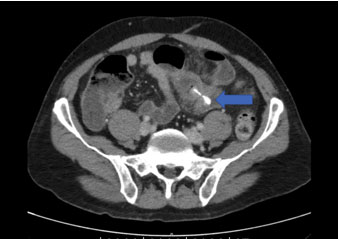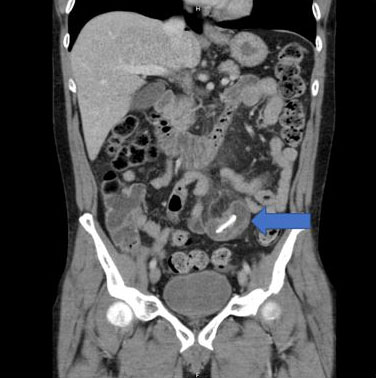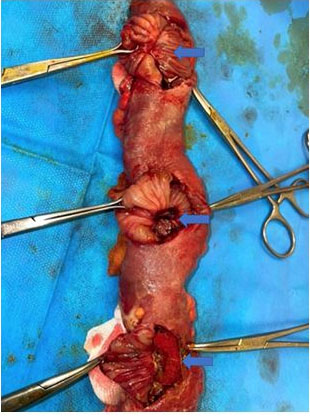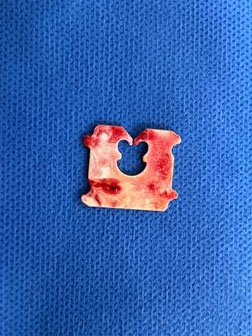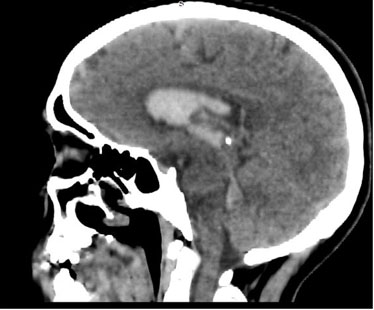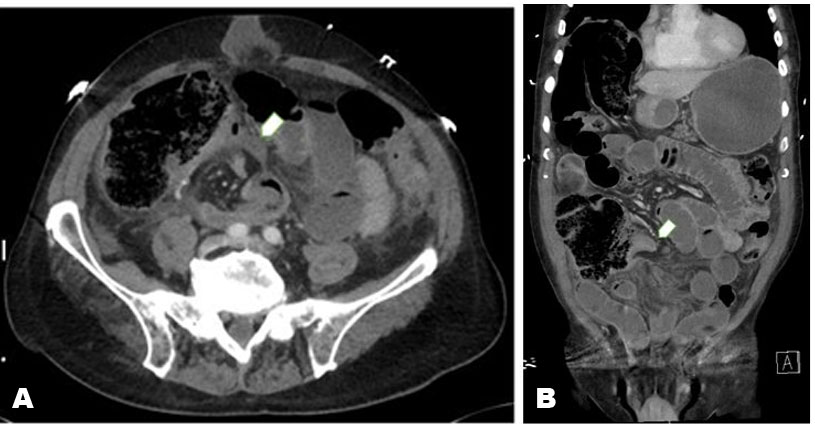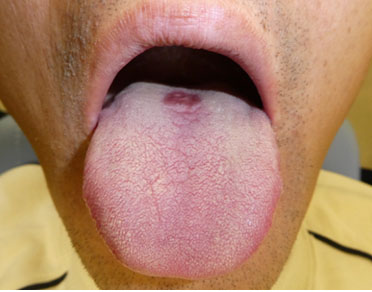 |
Case Report
Bread clip ingestion resulting in small bowel perforation: A case report
1 Surgical Registrar, General Surgical Department, Northern Health, Epping, Victoria, Australia
2 Surgical Fellow, General Surgical Department, Northern Health, Epping, Victoria, Australia
3 Consultant Surgeon, General Surgical Department, Northern Health, Epping, Victoria, Australia
Address correspondence to:
Hein Maung
185 Cooper Street, Epping, VIC 3076,
Australia
Message to Corresponding Author
Article ID: 100124Z06HM2023
Access full text article on other devices

Access PDF of article on other devices

How to cite this article
Maung H, Chong A, Al-Habbal Y. Bread clip ingestion resulting in small bowel perforation: A case report. Case Rep Int 2023;12(2):26–29.ABSTRACT
Bread clip ingestion is an avoidable, all too common cause of an acute surgical abdomen. Patients present with various symptoms ranging from dysphagia, bleeding, perforation, and death with few cases successfully passing without causing significant damage. The patient in this case had gastrointestinal symptoms for over 2 months with associated weight loss, mimicking a time length of malignancy. The clip was lodged in the small bowel, which is often the case. This study presents an uncommon presentation of symptoms with evidence of the varying degrees of bread clip injury, preceding perforation. Plastic resists enzymatic breakdown in the gastrointestinal tract, and its unique shape contributes to the bowel wall getting caught in between its jaws, followed by dislodgment through peristalsis, and eventual perforation. Despite publicity in Australian news articles, manufacturers and supermarkets still utilize products with plastic bread clips and present an avoidable health hazard to patients in this country.
Keywords: Bread clip, Emergency laparotomy, SBO, Small bowel obstruction
INTRODUCTION
In Australia, despite publicity from over 20 years ago [1],[2], and publications recommending substitution with cardboard [3], plastic bread clip injury is still an occurrence with patients sustaining significant morbidity [4]. In this case we present a patient with accidental ingestion of a plastic bread clip, with symptoms over a span of months mimicking malignancy. We demonstrate how bread clip injuries can cause some of the symptoms documented [3],[4],[5] with varying degrees of damage caused to the bowel wall.
CASE REPORT
A male in his 50s presented to the emergency department with 2 months of generalized abdominal pain, with associated intermittent distension and weight loss of 12 kg. He was opening his bowels normally and denied any melaena or rectal bleeding. Previous medical history included an open appendectomy and smoking. Examination demonstrated normal observations, abdomen was tender on the left periumbilical region and rectal exam demonstrated normal stools, and no masses.
Investigations
White cell count was raised at 13 × 109/L (3.5–9.6 × 109/L) with a C-reactive protein of 56 mg/L (<5 mg/L). Computed tomography was performed in the portal venous phase, demonstrating a foreign body in his mid to distal small bowel, causing thickening, stranding in the mesentery and localized free gas (Figure 1 and Figure 2), suggestive of a small bowel perforation.
Treatment
The patient was administered intravenous fluids and antibiotics and was taken to theatre for an emergency laparotomy. A limited laparotomy was performed, revealing loops of ileum with adhesions, and a segment containing the perforated portion of the ileum. Adhesiolysis was performed, contamination suctioned and 25 cm of affected small bowel was resected. A side-to-side stapled anastomosis was performed with a linear stapler. Macroscopic examination demonstrated multiple sites along with the ileum where the bread clip had embedded itself into the small bowel wall with 3 points of varying severity and the third distal embedment causing perforation with the bread clip in situ (Figure 3 and Figure 4).
The patient stayed in hospital for five days with intravenous antibiotics and was discharged once his bowels opened and his pain was controlled. Histologically, serositis was present with 3 sites of small bowel wall puckering consistent with bread tag injury. No malignancy was identified.
Clinical follow-up of two months after the surgery demonstrated a well healed wound, with normal bowel motions and a soft abdomen. The patient resumed full daily activities and returned to work without consequence.
DISCUSSION
Patients present with various symptoms ranging from bleeding, perforation, and death [4], with few cases successfully passing without causing significant damage [4]. The patient in this case had gastrointestinal symptoms over two months causing weight loss and mimicking a time length of malignancy. The bread clip was lodged in the small bowel, which is often the case [3]. The cause of pathology from bread clip ingestion is owing to its unique shape of jaws that clamp to bowel wall and bowel collects in the jaws, dislodges, and ulcerates, until bowel wall entrenches in the clip, and perforates [5],[6]. The composition of plastic also resists enzyme and acid breakdown [7],[8]. Liew et al. described a case of bread clip ingestion causing impaction in the colon. Endoscopy was attempted to retrieve the clip; however, they proceeded to laparotomy and colotomy. They identified 38 cases in total of bread clip ingestion in their discussion. Dentures appear to have an association with bread clip ingestion likely due to decreased oral sensation during mastication [3]. In this case, the patient didn’t have any history of intellectual disability, cognitive impairment, or dentures that would affect their ability to avoid this calamity.
While previously reported cases of bread tag ingestion exist, this report demonstrates the varying degrees of bread tag damage to bowel wall and explains the symptoms they cause.
CONCLUSION
Bread clip ingestion can present with a lengthy history of months, mimicking that of a malignancy on history and clinical examination alone. With the use of computed tomography bread clip ingestion is easily diagnosed. Generally, patients have predisposing factors such as intellectual disability or dentures; however, this case demonstrates bread clip ingestion can occur in any patient.
REFERENCE
1.
The Age: Australian Associated Press [Internet]. Melbourne (AU): The Age; 2014 [updated 2014 May 15; cited 2023 June 23]. [Available at: https://www.theage.com.au/national/victoria/bread-bag-clips-blamed-for-surgeries-and-deaths-20140515-zrdr0.html]

2.
News in Science: ABC Science Online. 2002. [Available at: https://www.abc.net.au/science/articles/2002/05/24/559564.htm]

3.
Chuang FJ, Townend PJ, Cooper ML. A case series of bread clip ingestions. J Surg Case Rep 2022;2022(6):rjac163. [CrossRef]
[Pubmed]

4.
Newell KJ, Taylor B, Walton JC, Tweedie EJ. Plastic bread-bag clips in the gastrointestinal tract: Report of 5 cases and review of the literature. CMAJ 2000;162(4):527–9.
[Pubmed]

5.
Liew AN, Suhardja TS, Arachchi A, Lim J. Plastic bread clip impacted in gastrointestinal tract: A case report and review of the literature. Clin J Gastroenterol 2019;12(5):441–6. [CrossRef]
[Pubmed]

6.
Bhardwaj N, Kanhere HA, Maddern GJ. Small bowel obstruction caused by a bread clip: A time and time again problem. ANZ J Surg 2016;86(1–2):94–5. [CrossRef]
[Pubmed]

7.
Andersen LM, Yuide P. Replacing plastic bread clips with cardboard will prevent bowel perforation. ANZ J Surg 2022;92(12):3195–7. [CrossRef]
[Pubmed]

8.
Yik B, Podboy A, Shah N. Open-and-shut case: An uncommon cause of GI bleeding. Dig Dis Sci 2019;64(7):1789–91. [CrossRef]
[Pubmed]

SUPPORTING INFORMATION
Acknowledgement
We would like to acknowledge the theatre staff of Northern Hospital and the General Surgical Department for their contributions and support.
Author ContributionsHein Maung - Conception of the work, Design of the work, Acquisition of data, Drafting the work, Revising the work critically for important intellectual content, Final approval of the version to be published, Agree to be accountable for all aspects of the work in ensuring that questions related to the accuracy or integrity of any part of the work are appropriately investigated and resolved.
Andrew Chong - Acquisition of data, Revising the work critically for important intellectual content, Final approval of the version to be published, Agree to be accountable for all aspects of the work in ensuring that questions related to the accuracy or integrity of any part of the work are appropriately investigated and resolved.
Yahya Al-Habbal - Revising the work critically for important intellectual content, Final approval of the version to be published, Agree to be accountable for all aspects of the work in ensuring that questions related to the accuracy or integrity of any part of the work are appropriately investigated and resolved.
Guarantor of SubmissionThe corresponding author is the guarantor of submission.
Source of SupportNone
Consent StatementWritten informed consent was obtained from the patient for publication of this article.
Data AvailabilityAll relevant data are within the paper and its Supporting Information files.
Conflict of InterestAuthors declare no conflict of interest.
Copyright© 2023 Hein Maung et al. This article is distributed under the terms of Creative Commons Attribution License which permits unrestricted use, distribution and reproduction in any medium provided the original author(s) and original publisher are properly credited. Please see the copyright policy on the journal website for more information.


